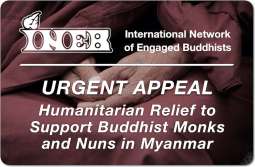[saṅgīti] Buddhist Council. The first Council was held in the rainy season following the parinirvāṇa of the Buddha. It was held at Rājagṛha, the capital of Magadha, around 483 BC. King Ajātaśatru donated the site near Rājagṛha for the assembly. Tradition states that around five hundred monks known as 'the great elders' (mahāsthavirāḥ) [mahātherā] assembled in a cave called Saptaparṇi [Sattapaṇṇi]. The purpose of the assembly was to fix a canon of religion (Dharma) and orderly discipline (Vinaya). It was presided over by Kāśyapa also known as Mahākāśyapa, the disciple of the Buddha. He recited sthaviravāda [theravāda] 'words of elders' -- the precepts of the Buddha as were recorded in the memory of the older men. Upāli recited the rules of discipline (Vinaya) and Ānanda recited the discourses of the Buddha [Sutta].
One hundred years after the death of the Buddha the second Council was held at Vaiśāli near Paṭanā about 380 BC. Seven hundred monks participated in the Council which lasted for eight months. Its purpose was to uphold the discipline of the saṅgha. Deviation from the rules prescribed for the order of discipline was discussed at length and unlawful relaxations, such as accepting money as a gift, eating a second meal in the afternoon, etc. were prohibited. The doctrine was revised and the core of the texts took a certain shape.
The third council was held at Paṭanā (Pāṭaliputra) about 244-242 BC in the reign of king Aśoka to find a way out from the then existing controversies. A canon of texts was compiled in the Council. Tradition says that Tissa Moggaliputta convened an assembly of a thousand monks in order to compile a canon of texts of the Theravāda. He compiled Kathāvatthu and inserted it into the canon. It is surmised that the participants of the third Council put the books of the Abhidhamma at the end.
This Council was a turning point in the history of Buddhism because as a consequence of the deliberations in the Councils, the propagation of Buddhism was undertaken and Mahendra [Mahinda], the son of king Aśoka went to Sri Lanka for the mission, and carried the texts of the canon along with him. About 83 BC, a Council of Arhat-s was held during the reign of Siṃhala King Vaṭṭa Gāmani Abhaya and the Tipiṭaka was written at Aluvihara in Sri Lanka.
The fourth council was held around ad 100 at Jalandhar in Kashṃir under the auspices of king Kaniṣka who was from the Śaka race. He sought advice from Pārśva as he was desirous to settle the dissensions in the brotherhood. The eighteen sects were acknowledged and were declared to contain the doctrine. The king built a monastery and invited monks to write commentaries on the Tripiṭaka-s. Accordingly, the three commentaries Upadeśa, Vinaya Vibhāṣa and Abhidhamma Vibhāṣā were composed. The commentaries on all the piṭaka-s consisted of 100,000 śloka-s each. These were the earliest books on the Mahāyāna. The language used in proceedings was most probably Sanskrit. This can be regarded as a special feature of the fourth council. Hereafter Sanskrit dominated Buddhist literature.













